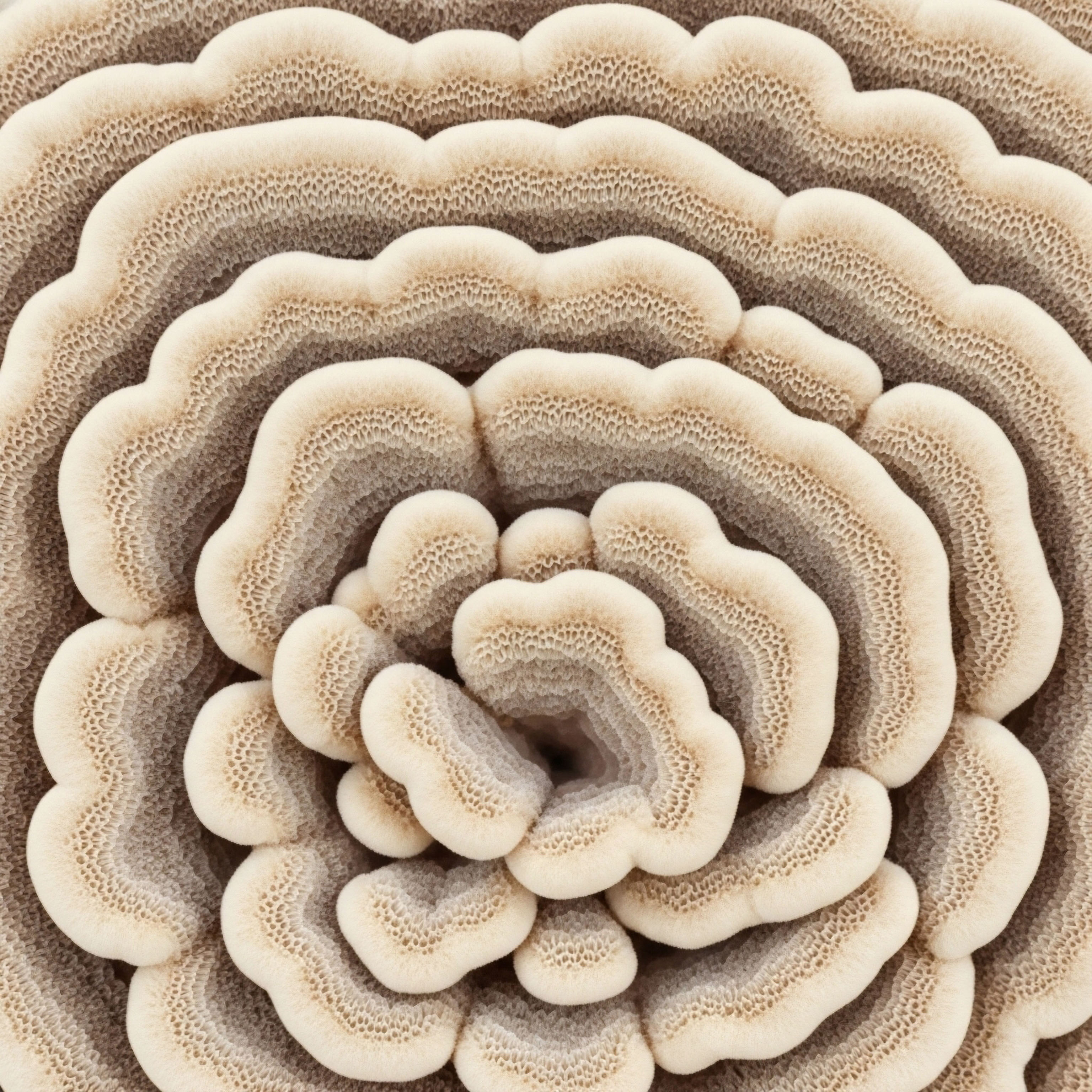

Fundamentals
Experiencing shifts in your body’s rhythm, particularly when contemplating fertility, can bring about a sense of disquiet. Perhaps you notice a subtle change in energy, a persistent feeling of being out of sync, or a quiet concern about your reproductive potential.
These sensations are not isolated incidents; they are often whispers from your internal communication system, signaling that something within your intricate biological machinery seeks attention. Your body operates as a sophisticated network, where every component influences the others. Understanding these connections offers a path to restoring balance and reclaiming a sense of well-being.
The human body maintains its internal environment through a complex system of chemical messengers. These messengers, known as hormones, travel through the bloodstream, carrying instructions to various organs and tissues. This elaborate communication network, the endocrine system, orchestrates nearly every bodily function, from metabolism and mood to growth and reproduction. When this system functions optimally, a feeling of vitality and equilibrium prevails. When imbalances arise, symptoms can manifest in diverse ways, including those affecting reproductive capacity.
Your body’s internal communication system, the endocrine network, governs overall well-being and reproductive capacity.
At the heart of reproduction lie specialized cells ∞ gametes. In males, these are sperm, produced through a continuous process called spermatogenesis. In females, these are oocytes, or eggs, which develop within the ovaries through oogenesis. The quality of these gametes is paramount for successful conception and healthy offspring.
Their development is tightly regulated by a central command center known as the Hypothalamic-Pituitary-Gonadal (HPG) axis. This axis functions like a finely tuned thermostat, adjusting hormone levels to ensure proper reproductive function.

The HPG Axis a Regulatory Circuit
The HPG axis begins in the hypothalamus, a region of the brain that releases gonadotropin-releasing hormone (GnRH) in a pulsatile manner. This GnRH then travels to the pituitary gland, a small organ situated at the base of the brain. The pituitary, in response to GnRH, secretes two critical hormones ∞ luteinizing hormone (LH) and follicle-stimulating hormone (FSH).
These gonadotropins then travel to the gonads ∞ the testes in males and the ovaries in females ∞ to stimulate gamete production and sex hormone synthesis.
- Hypothalamus ∞ Initiates the cascade by releasing GnRH.
- Pituitary Gland ∞ Responds to GnRH by secreting LH and FSH.
- Gonads ∞ Produce gametes and sex hormones under the influence of LH and FSH.
In males, LH stimulates the Leydig cells in the testes to produce testosterone, a hormone essential for spermatogenesis and male characteristics. FSH acts on Sertoli cells, which support and nourish developing sperm. In females, FSH promotes the growth of ovarian follicles, each containing an oocyte, while LH triggers ovulation and the production of progesterone and estrogen. This intricate feedback loop ensures that hormone levels remain within a healthy range, allowing for consistent gamete development.

Peptides Signaling Molecules
Peptides are short chains of amino acids, the building blocks of proteins. They act as signaling molecules within the body, carrying out a vast array of functions. Many hormones, neurotransmitters, and growth factors are peptides. Their precise structures allow them to bind to specific receptors, initiating targeted biological responses. Unlike larger proteins, peptides often possess a high degree of specificity and a favorable safety profile, making them subjects of intense scientific inquiry for therapeutic applications.
The study of peptides in health and wellness represents a dynamic frontier. Researchers are constantly uncovering new ways these natural compounds can influence bodily systems, including those governing reproduction. Understanding how these smaller signaling molecules interact with the larger endocrine network provides a deeper appreciation for the body’s self-regulatory capacities. This knowledge also opens avenues for interventions that aim to support and optimize biological processes, rather than simply replacing deficient substances.


Intermediate
For individuals navigating concerns about hormonal balance and fertility, the path often involves a careful consideration of various therapeutic protocols. Traditional approaches to hormonal optimization, such as Testosterone Replacement Therapy (TRT), offer significant benefits for symptoms related to low hormone levels. However, these interventions can also introduce complexities, particularly concerning reproductive function. Understanding the mechanisms of these therapies, alongside specialized fertility-stimulating protocols and growth hormone peptides, becomes paramount for informed decision-making.

Testosterone Replacement Therapy and Fertility Considerations
Testosterone Replacement Therapy is a common intervention for men experiencing symptoms of low testosterone, often associated with aging or hypogonadism. Protocols typically involve regular injections of Testosterone Cypionate. While TRT effectively alleviates symptoms such as fatigue, reduced libido, and decreased muscle mass, it can also suppress the body’s natural testosterone production. This suppression occurs because the exogenous testosterone signals the brain to reduce its output of LH and FSH, which are essential for stimulating sperm production in the testes.
Testosterone replacement therapy can improve symptoms of low testosterone but may suppress natural sperm production.
For men who wish to maintain or restore fertility while on TRT, or after discontinuing it, specific strategies are employed. These strategies aim to reactivate the HPG axis and support endogenous hormone production. One such approach involves the use of Gonadorelin, a synthetic form of GnRH.
When administered in a pulsatile manner, Gonadorelin mimics the natural release pattern of GnRH from the hypothalamus, thereby stimulating the pituitary gland to secrete LH and FSH. This, in turn, encourages the testes to produce testosterone and sperm, helping to preserve testicular size and function.
Other medications frequently incorporated into fertility-stimulating protocols for men include Tamoxifen and Clomid (clomiphene citrate). These agents are selective estrogen receptor modulators (SERMs). They work by blocking estrogen receptors in the hypothalamus and pituitary, which reduces the negative feedback that estrogen exerts on GnRH, LH, and FSH production.
By increasing the circulating levels of these gonadotropins, Tamoxifen and Clomid can stimulate testicular function and improve sperm parameters, such as concentration and motility. Anastrozole, an aromatase inhibitor, may also be used to prevent the conversion of testosterone to estrogen, which can further support testosterone levels and reduce estrogen-related side effects.

Female Hormonal Balance and Fertility
For women, hormonal balance is equally critical for reproductive health. Symptoms like irregular cycles, mood changes, and low libido can signal imbalances. Testosterone, while primarily a male hormone, plays a vital role in female physiology, including ovarian function and libido.
Low-dose testosterone therapy, often with Testosterone Cypionate via subcutaneous injection or pellet therapy, can be considered for women with relevant symptoms. Progesterone is also a key hormone, particularly in peri-menopausal and post-menopausal women, supporting uterine health and overall hormonal equilibrium. Research indicates that testosterone may influence follicle development and oocyte quality, particularly in women with poor ovarian response in IVF cycles.

Growth Hormone Peptide Therapy and Reproductive Health
Beyond direct reproductive hormones, other signaling molecules, such as growth hormone-releasing peptides, play a role in overall metabolic function, which indirectly impacts reproductive health. Peptides like Sermorelin, Ipamorelin, and CJC-1295 are classified as growth hormone secretagogues. They work by stimulating the pituitary gland to produce and release its own natural growth hormone (GH). GH is a powerful metabolic hormone involved in cellular repair, muscle growth, fat metabolism, and sleep regulation.
While these peptides are primarily used for anti-aging, muscle gain, fat loss, and sleep improvement, their systemic effects can create a more favorable internal environment for gamete quality. Improved metabolic health, reduced inflammation, and enhanced cellular regeneration can all contribute to better reproductive outcomes. For instance, GH has been shown to influence both spermatogenesis and oogenesis, suggesting a broader role in gonadal function.
Other targeted peptides, such as PT-141 (Bremelanotide), directly address sexual health. PT-141 acts on melanocortin receptors in the brain to increase sexual desire and arousal in both men and women, addressing aspects of sexual dysfunction that can impact fertility efforts. While not directly improving gamete quality, it supports the physiological and psychological aspects of conception.
Pentadeca Arginate (PDA), a peptide known for tissue repair, healing, and anti-inflammatory properties, contributes to overall systemic health, which indirectly supports reproductive organ function and cellular integrity.
Peptides like Sermorelin and Ipamorelin stimulate natural growth hormone, supporting overall metabolic health that can indirectly benefit reproductive function.

Comparing Fertility Protocols
The choice of protocol depends on individual circumstances, including the underlying cause of infertility, hormonal status, and specific reproductive goals. A tailored approach, guided by comprehensive laboratory testing and clinical assessment, ensures the most appropriate and effective intervention.
| Agent | Primary Mechanism | Targeted Application |
|---|---|---|
| Gonadorelin | Pulsatile GnRH analog; stimulates pituitary LH/FSH release. | Male fertility preservation on TRT, hypogonadotropic hypogonadism. |
| Tamoxifen / Clomid | SERMs; block estrogen negative feedback, increasing LH/FSH. | Male idiopathic infertility, sperm parameter improvement. |
| Testosterone (Low-Dose) | Direct androgen supplementation; influences ovarian function. | Female hormonal balance, potential oocyte quality in poor responders. |
| Sermorelin / Ipamorelin | GH secretagogues; stimulate natural GH release. | Overall metabolic health, cellular repair, indirect reproductive support. |
| PT-141 | Melanocortin receptor agonist; increases sexual desire. | Sexual dysfunction in men and women, supporting conception. |
Each of these agents plays a distinct role within the broader strategy of optimizing reproductive health. Their application requires a deep understanding of endocrine physiology and individual patient needs. The aim is always to restore biological harmony, thereby creating conditions conducive to improved gamete quality and successful reproductive outcomes.


Academic
The question of whether peptide therapies directly improve gamete quality for fertility requires a rigorous examination of underlying biological mechanisms and clinical evidence. While some peptides exert direct influence on reproductive axes, others contribute to an environment conducive to optimal gamete development through systemic effects. A deep understanding of endocrinology, cellular biology, and the interplay of various physiological systems is essential to appreciate their potential.

The Hypothalamic-Pituitary-Gonadal Axis Rebalancing
The HPG axis stands as the central regulatory system for reproduction. Its precise pulsatile signaling is critical for the maturation of both sperm and oocytes. When this pulsatility is disrupted, as seen in conditions like hypogonadotropic hypogonadism or suppression from exogenous hormones, gamete production suffers.
Gonadorelin, a synthetic GnRH, directly addresses this disruption. Administered in a pulsatile fashion, it bypasses a dysfunctional hypothalamus to stimulate the pituitary’s release of LH and FSH. This direct stimulation of the gonadotropins then acts upon the gonads.
In males, LH stimulates Leydig cells to produce intratesticular testosterone, which is present at concentrations significantly higher than systemic levels and is essential for normal spermatogenesis. FSH, acting on Sertoli cells, supports germ cell development and maturation. The restoration of this endogenous signaling pathway can lead to improved sperm concentration, motility, and morphology, directly enhancing male gamete quality.
Similarly, in females, pulsatile GnRH administration can induce ovulation in anovulatory conditions by restoring the physiological release of LH and FSH, which are necessary for follicular development and oocyte maturation. The precise timing and amplitude of these gonadotropin surges are critical for the final stages of oocyte development and release.

How Do Growth Hormone Peptides Influence Gamete Development?
Growth hormone (GH) and its downstream mediator, Insulin-like Growth Factor 1 (IGF-1), are well-known for their roles in growth and metabolism. However, their influence extends to the reproductive system, impacting both spermatogenesis and oogenesis. Peptides such as Sermorelin, Ipamorelin, and CJC-1295 stimulate the endogenous release of GH from the pituitary gland. This indirect approach to increasing GH levels offers a physiological advantage, as it maintains the body’s natural feedback mechanisms, avoiding the supraphysiological spikes associated with exogenous GH administration.
In the testes, GH and IGF-1 receptors are present on Leydig cells and Sertoli cells. GH can directly stimulate testosterone synthesis in Leydig cells and support the proliferative and differentiative processes of germ cells within the seminiferous tubules. Studies suggest that GH can improve sperm parameters, including motility and morphology, by supporting the microenvironment necessary for spermatogenesis. This influence is not always direct on the gamete itself, but rather on the supporting cells and hormonal milieu that govern its development.
For female gametes, GH and IGF-1 play a role in ovarian folliculogenesis and oocyte maturation. GH receptors are found on granulosa cells, which surround and nourish the developing oocyte within the follicle. GH can enhance the sensitivity of these cells to FSH, promoting follicular growth and increasing the number of mature oocytes retrieved in assisted reproductive technologies. The precise mechanisms involve modulation of intracellular signaling pathways that regulate cell proliferation and differentiation within the ovarian follicle.
Growth hormone peptides can indirectly support gamete quality by optimizing the cellular environment and hormonal signals within the gonads.

Can Systemic Wellness Peptides Improve Gamete Quality?
Beyond direct hormonal regulation, systemic health plays a significant role in reproductive function. Chronic inflammation, oxidative stress, and metabolic dysfunction can all negatively impact gamete quality. Peptides like Pentadeca Arginate (PDA), known for its regenerative and anti-inflammatory properties, contribute to overall tissue health and repair.
While PDA does not directly target gamete production, its ability to reduce systemic inflammation and promote cellular integrity can create a more favorable physiological environment for spermatogenesis and oogenesis. A healthier cellular environment, with reduced oxidative damage, is conducive to the production of higher quality gametes.
Similarly, PT-141 (Bremelanotide), while primarily targeting sexual desire and arousal through central nervous system pathways, can indirectly support fertility efforts by addressing psychological and physiological barriers to intercourse. While it does not directly influence gamete quality at a cellular level, its role in facilitating the act of conception is undeniable.

Mechanisms of Peptide Influence on Gamete Quality
The mechanisms by which peptides might influence gamete quality are complex and often indirect, involving the optimization of the endocrine environment, cellular metabolism, and tissue integrity.
- Hormonal Axis Modulation ∞ Peptides like Gonadorelin directly stimulate the HPG axis, ensuring appropriate levels of LH and FSH, which are indispensable for gamete maturation.
- Growth Factor Signaling ∞ GH-releasing peptides increase endogenous GH and IGF-1, which act as growth factors within the gonads, supporting germ cell proliferation and differentiation.
- Metabolic Optimization ∞ Improved metabolic health, a consequence of balanced GH levels, reduces systemic stressors that can impair gamete quality.
- Anti-Inflammatory Effects ∞ Peptides with anti-inflammatory properties, such as PDA, mitigate cellular damage and create a healthier microenvironment for gamete development.
- Oxidative Stress Reduction ∞ Some peptides may possess antioxidant properties, protecting delicate gametes from oxidative damage, a known contributor to reduced quality.
The table below summarizes the proposed mechanisms by which various peptides may influence gamete quality, either directly or indirectly.
| Peptide Class | Primary Mechanism of Action | Influence on Gamete Quality |
|---|---|---|
| GnRH Analogs (e.g. Gonadorelin) | Direct HPG axis stimulation; pulsatile LH/FSH release. | Directly enhances spermatogenesis and oogenesis by restoring physiological hormonal signals. |
| GH Secretagogues (e.g. Sermorelin, Ipamorelin) | Stimulate endogenous GH/IGF-1 release. | Indirectly supports gamete development through improved gonadal microenvironment, cellular metabolism, and growth factor signaling. |
| Tissue Repair Peptides (e.g. Pentadeca Arginate) | Reduce inflammation, promote tissue repair and angiogenesis. | Indirectly supports gamete quality by reducing systemic stress and optimizing overall reproductive organ health. |
| Melanocortin Agonists (e.g. PT-141) | Modulate central nervous system pathways for sexual desire. | Indirectly supports fertility by addressing sexual dysfunction, facilitating conception. |

What Clinical Evidence Supports Peptide Use for Gamete Quality?
While the theoretical mechanisms are compelling, clinical evidence specifically linking peptide therapies directly to improved gamete quality for fertility is still evolving. Research on Gonadorelin for male fertility preservation, particularly in men on TRT or with hypogonadotropic hypogonadism, shows promising results in restoring sperm production. Studies on growth hormone’s role in reproductive function, often using recombinant GH, suggest a beneficial impact on both male and female gamete parameters, providing a basis for investigating GH-releasing peptides.
However, large-scale, randomized controlled trials specifically evaluating the direct impact of peptides like Sermorelin, Ipamorelin, or Pentadeca Arginate on human gamete quality are less common. Much of the evidence for these peptides in reproductive contexts is extrapolated from their known systemic effects on metabolism, inflammation, and cellular health. The scientific community continues to gather data to clarify the precise roles and efficacy of these agents in optimizing gamete quality.

How Do Hormonal Interventions Influence Reproductive Outcomes?
The interplay between various hormonal interventions and reproductive outcomes is complex. For instance, while TRT can suppress spermatogenesis, the use of Gonadorelin, Tamoxifen, or Clomid aims to counteract this suppression by stimulating the body’s own gonadotropin production. This re-establishes the delicate balance required for healthy sperm development. The success of these interventions hinges on a thorough understanding of the individual’s endocrine profile and the specific mechanisms of action of each agent.
Similarly, in women, the careful application of low-dose testosterone or progesterone, guided by comprehensive lab work, seeks to optimize the ovarian environment. This can potentially enhance follicular response and oocyte maturation, particularly in challenging cases of diminished ovarian reserve. The goal is always to recalibrate the body’s internal systems, allowing for its innate reproductive capabilities to function more effectively.

References
- Pyo, Yeonhee, and Ki Han Kwon. “Aging, testosterone and male fertility therapy ∞ a review.” Journal of Men’s Health 20.8 (2024) ∞ 1-10.
- Siddiqui, Dainyal, et al. “Can testosterone replacement therapy (TRT) affect male fertility?” Dr.Oracle (2025).
- Zhang, Y. et al. “The Pulsatile Gonadorelin Pump Induces Earlier Spermatogenesis Than Cyclical Gonadotropin Therapy in Congenital Hypogonadotropic Hypogonadism Men.” PubMed Central (2023).
- Empower Pharmacy. “Compounded Gonadorelin in Men’s Health.” (2024).
- Ghasemi, M. et al. “Revisiting oestrogen antagonists (clomiphene or tamoxifen) as medical empiric therapy for idiopathic male infertility ∞ a meta-analysis.” Andrology 12.1 (2024) ∞ 1-10.
- Al-Hathal, N. et al. “Efficacy of clomiphene citrate and tamoxifen on pregnancy rates in idiopathic male subfertility ∞ A systematic review and meta-analysis.” Asian Journal of Urology 12.1 (2025) ∞ 15-22.
- Mirzaeian, S. et al. “The effect of testosterone gel on fertility outcomes in women with a poor response in in vitro fertilization cycles ∞ A pilot randomized clinical trial.” International Journal of Reproductive Biomedicine 16.1 (2018) ∞ 29-36.
- Hammes, Stephen R. et al. “Female Fertility ∞ What’s Testosterone Got To Do With It?” URMC Newsroom (2014).
- Houston Men’s Health Clinic. “SERMORELIN/IPAMORELIN.” (n.d.).
- Evolve Medical Group. “Ipamorelin vs Sermorelin.” (n.d.).
- Hull, K. L. and M. L. Harvey. “Growth Hormone and Reproduction ∞ A Review of Endocrine and Autocrine/Paracrine Interactions.” Molecular and Cellular Endocrinology 226.1-2 (2004) ∞ 1-16.
- Wang, Y. et al. “Effects of growth hormone on lipid metabolism and sexual development in pubertal obese male rats.” Journal of Animal Science and Biotechnology 13.1 (2022) ∞ 1-10.
- Diamond, L. E. et al. “PT-141 ∞ a melanocortin agonist for the treatment of sexual dysfunction.” Annals of the New York Academy of Sciences 994.1 (2003) ∞ 96-102.
- Concierge MD. “PT 141 Peptide Pros and Cons ∞ Understanding Its Benefits And Risks.” (2025).
- All U Health. “Pentadeca Arginate ∞ Next-Gen BPC-157 for Healing & Recovery.” (n.d.).
- Yunique Medical. “Head-to-Head ∞ Pentadeca Arginate vs. BPC 157.” (2025).

Reflection
Considering your own biological systems is a deeply personal undertaking. The information presented here offers a glimpse into the intricate world of hormonal health and its connection to reproductive vitality. This knowledge is not merely a collection of facts; it is a framework for understanding your body’s inherent wisdom and its capacity for recalibration. Recognizing the subtle signals your body sends, and then seeking informed guidance, represents a powerful step toward reclaiming your well-being.
Your health journey is unique, shaped by your individual physiology and life experiences. The pathways discussed, from targeted hormonal support to the broader influence of peptides on systemic health, underscore the interconnectedness of all bodily functions. Approaching your health with curiosity and a desire for deeper understanding allows for a more personalized and effective strategy. This exploration is an ongoing process, one that invites continuous learning and adaptation.
The pursuit of optimal health is a collaborative effort between you and knowledgeable clinical professionals. The insights gained from exploring these complex topics serve as a foundation, enabling more meaningful conversations about your specific needs and aspirations. Trusting your intuition about your body, combined with evidence-based scientific understanding, creates a powerful synergy. This synergy guides you toward a future where vitality and function are not compromised, but rather restored and sustained.



